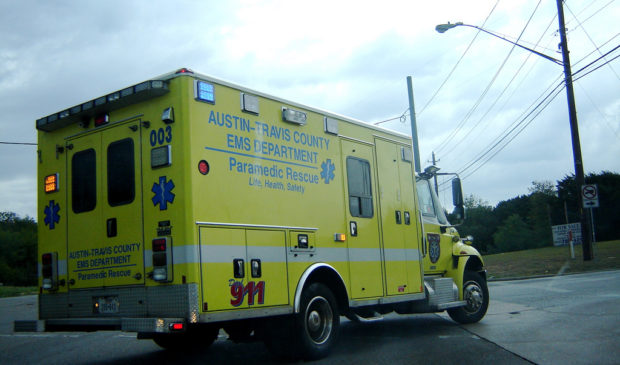Low morale in Austin’s public safety departments requires attention
Tuesday, October 2, 2018 by
Jessi Devenyns The Public Safety Commission heard a variety of concerns at its Oct. 1 meeting in regards to the chronic low morale that public safety officers are experiencing within their respective departments.
“It is pretty unanimous the officers are really getting tired of it,” said Commissioner Preston Tyree, who co-sponsored the discussion topic on the commission’s agenda. “I wanted it out in the public, and I wanted it on the record.”
Austin Firefighters Association President Bob Nicks underscored the issue when he told the commission that 87 percent of those surveyed in the Fire Department responded “yes” to the question, “Is firefighter morale an issue that the new fire chief needs to address?”
“There is a big disconnect between command staff and the rank and file,” he said. Similarly, Austin Police Association President Ken Casaday and Austin-Travis County Emergency Medical Services Association President Tony Marquardt agreed that the overall sentiments within the public safety departments need to take a 180-degree turn – and fast.
“Morale,” said Casaday, “is the worst I’ve ever seen it in 21 years.”
Part of the issue for the Police Department stems from the loss of its city contract last December. In the past 247 days, Casaday said he has seen field-trained officers quit because they are not being paid what they were accustomed to receiving before the contract was canceled. According to him the number of officers who have resigned since the cancellation of the contract is “surprising.”
“The best people are the ones who are quitting – because they have options elsewhere,” Commissioner Kim Rossmo agreed.
Of those who have not resigned, Casaday noted that they are less enthusiastic to show up to work. “Traffic citations are down 73 percent,” said Casaday. “You’re starting to see violent crime go up.”
Assistant Police Chief Troy Gay clarified that “In 2017 we did see a slight uptick (in violent crime), but in 2018 we are actually on the down.” He said the overall reduction this year is between 3 and 4 percent.
Although the EMS and fire departments do not have to deal with contract cancellations demoralizing their staff, statistics and surveys indicate that overutilized “draconian” punishments, as well as increasing cases of post-traumatic stress disorder, are chipping away at morale.
“Bad morale can reduce productivity in an organization by 15 to 20 percent,” said Rossmo. That translates into real dollars. Of the $660 million, or 68 percent, of the city budget that is devoted to public safety (per 2017 budget), “we are looking to close to $100 million potentially lost because we’re not getting what we paid for.”
Perhaps worse than the financial burden that low morale presents is the well-being costs it translates to for the officers. According to APD Senior Chaplain Rick Randall, if this trend continues, in 20 years, officer divorce rates will hover around 80 percent, alcohol abuse will be 300 percent more likely, and suicide rates for those in the profession will rest between the second and third spot for frequency nationwide.
“Most significantly, they will have a life expectancy that is 15 years less than the average person walking on the street,” said Randall. “That’s just the wear and tear of this job.”
It’s unclear where these figures came from.
However, there have been positive signs that attitudes of the public safety department staff are shifting. “Things are seeming to trend upward, although I think it’s going to take a year or two,” noted Nicks.
In terms of documenting unnecessary or overly harsh punishments, body cameras “have really been a huge success in our department,” said Casaday. As for mental health, all three branches of the public safety departments are considering it a top priority to address. Now each department has a peer support team as well as access to affordable treatment through recently passed legislation that covers PTSD under workers’ compensation for first responders in the state.
The departments’ focus on addressing health and wellness proactively as well as close monitoring of the “toxic approach” of punishing minor infractions in hopes of gaining overall compliance from the officers to department rules has the leaders feeling hopeful.
“I think Austin has an opportunity to be cutting-edge when it comes to this (aspect) of employee wellness,” said Randall.
As it will take time to document the effects of the efforts, Rossmo requested that the union officials return in December with an update on the progress of morale improvement.
“I don’t like the idea of a less-effective public safety (division) … because morale is bad,” he said.
Photo by Andreanna Moya Photography, from Flickr, made available by a Creative Commons license.
The Austin Monitor’s work is made possible by donations from the community. Though our reporting covers donors from time to time, we are careful to keep business and editorial efforts separate while maintaining transparency. A complete list of donors is available here, and our code of ethics is explained here.
You're a community leader
And we’re honored you look to us for serious, in-depth news. You know a strong community needs local and dedicated watchdog reporting. We’re here for you and that won’t change. Now will you take the powerful next step and support our nonprofit news organization?






